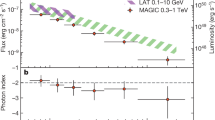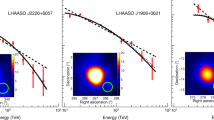Abstract
Very energetic astrophysical events are required to accelerate cosmic rays to above 1018 electronvolts. GRBs (γ-ray bursts) have been proposed as possible candidate sources1,2,3. In the GRB ‘fireball’ model, cosmic-ray acceleration should be accompanied by neutrinos produced in the decay of charged pions created in interactions between the high-energy cosmic-ray protons and γ-rays4. Previous searches for such neutrinos found none, but the constraints were weak because the sensitivity was at best approximately equal to the predicted flux5,6,7. Here we report an upper limit on the flux of energetic neutrinos associated with GRBs that is at least a factor of 3.7 below the predictions4,8,9,10. This implies either that GRBs are not the only sources of cosmic rays with energies exceeding 1018 electronvolts or that the efficiency of neutrino production is much lower than has been predicted.
This is a preview of subscription content, access via your institution
Access options
Subscribe to this journal
Receive 51 print issues and online access
$199.00 per year
only $3.90 per issue
Buy this article
- Purchase on Springer Link
- Instant access to full article PDF
Prices may be subject to local taxes which are calculated during checkout




Similar content being viewed by others
References
Waxman, E. Cosmological gamma-ray bursts and the highest energy cosmic rays. Phys. Rev. Lett. 75, 386–389 (1995)
Vietri, M. The acceleration of ultra-high-energy cosmic rays in gamma-ray bursts. Astrophys. J. 453, 883–889 (1995)
Milgrom, M. & Usov, V. Possible association of ultra-high-energy cosmic-ray events with strong gamma-ray bursts. Astrophys. J. 449, L37 (1995)
Waxman, E. & Bahcall, J. High energy neutrinos from cosmological gamma-ray burst fireballs. Phys. Rev. Lett. 78, 2292–2295 (1997)
Avrorin, A. V. et al. Search for neutrinos from gamma-ray bursts with the Baikal neutrino telescope NT200. Astron. Lett. 37, 692–698 (2011)
Abbasi, R. et al. Search for muon neutrinos from gamma-ray bursts with the IceCube neutrino telescope. Astrophys. J. 710, 346–359 (2010)
Abbasi, R. et al. Limits on neutrino emission from gamma-ray bursts with the 40 string IceCube detector. Phys. Rev. Lett. 106, 141101 (2011)
Rachen, J. P. & Mészáros, P. in Fourth Huntsville Gamma-Ray Burst Symposium (eds Meegan, C. A., Preece, R. D. & Koshut, T. M. ) 776–780 (American Institute of Physics Conference Proceedings Vol. 428, 1998)
Guetta, D., Hooper, D., Alvarez-Muñiz, J., Halzen, F. & Reuveni, E. Neutrinos from individual gamma-ray bursts in the BATSE catalog. Astropart. Phys. 20, 429–455 (2004)
Ahlers, M., Gonzalez-Garcia, M. C. & Halzen, F. GRBs on probation: testing the UHE CR paradigm with IceCube. Astropart. Phys. 35, 87–94 (2011)
Becker, J. K. High-energy neutrinos in the context of multimessenger astrophysics. Phys. Rep. 458, 173–246 (2008)
Abbasi, R. et al. The IceCube data acquisition system: signal capture, digitization, and timestamping. Nucl. Instrum. Methods Phys. Res. A 601, 294–316 (2009)
Ahrens, J. et al. Muon track reconstruction and data selection techniques in AMANDA. Nucl. Instrum. Methods Phys. Res. A 524, 169–194 (2004)
GCN: The Gamma-ray Coordinates Network. http://gcn.gsfc.nasa.gov.
Guetta, D., Spada, M. & Waxman, E. On the neutrino flux from gamma-ray bursts. Astrophys. J. 559, 101–109 (2001)
Baerwald, P., Hümmer, S. & Winter, W. Systematics in aggregated neutrino fluxes and flavor ratios from gamma-ray bursts. Astropart. Phys. 35, 508–529 (2012)
Hümmer, S., Baerwald, P. & Winter, W. Neutrino emission from gamma-ray burst fireballs, revised. Preprint at http://ArXiv.org/abs/1112.1076 (2011)
Mészáros, P. Gamma-ray bursts. Rep. Prog. Phys. 69, 2259–2321 (2006)
Becker, J. K., Stamatikos, M., Halzen, F. & Rhode, W. Coincident GRB neutrino flux predictions: implications for experimental UHE neutrino physics. Astropart. Phys. 25, 118–128 (2006)
Waxman, E. Astrophysical sources of high energy neutrinos. Nucl. Phys. B Proc. Suppl. 118353–362 (2003)
Feldman, G. J. & Cousins, R. D. Unified approach to the classical statistical analysis of small signals. Phys. Rev. D 57, 3873–3889 (1998)
Acknowledgements
We acknowledge support from the following agencies: US NSF, Office of Polar Programs, and US NSF, Physics Division; University of Wisconsin Alumni Research Foundation; the GLOW and OSG grids; US DOE, NERSCC; the LONI grid; NSERC, Canada; Swedish Research Council, Swedish Polar Research Secretariat, SNIC, K. and A. Wallenberg Foundation, Sweden; German Ministry for Education and Research, Deutsche Forschungsgemeinschaft; Research Department of Plasmas with Complex Interactions (Bochum), Germany; FSR, FWO Odysseus, IWT, BELSPO, Belgium; University of Oxford, UK; Marsden Fund, New Zealand; Australian Research Council; JSPS, Japan; SNSF, Switzerland. J.P.R was supported by the Capes Foundation, Brazil; N.W. by the NSF GRFP. We thank S. Hümmer, E. Waxman and W. Winter for discussions.
Author information
Authors and Affiliations
Consortia
Contributions
The IceCube observatory was designed and constructed by the IceCube Collaboration and the IceCube Project. It is operated by the IceCube Collaboration, who set science goals. Data processing and calibration, Monte Carlo simulations of the detector and of theoretical models, and data analyses were performed by a large number of IceCube members who also discussed and approved the scientific results. This manuscript was written by P.R. and N.W. and subjected to an internal collaboration-wide review process. All authors approved the final version of the manuscript.
Corresponding authors
Ethics declarations
Competing interests
The author declare no competing financial interests.
Supplementary information
Supplementary Information
This file contains Supplementary Text and Supplementary Figures 1-4. (PDF 316 kb)
Supplementary Data
This file contains Supplementary Data files 1-6. (ZIP 33 kb)
Rights and permissions
About this article
Cite this article
IceCube Collaboration. An absence of neutrinos associated with cosmic-ray acceleration in γ-ray bursts. Nature 484, 351–354 (2012). https://doi.org/10.1038/nature11068
Received:
Accepted:
Published:
Issue Date:
DOI: https://doi.org/10.1038/nature11068
This article is cited by
-
Multi-messenger astrophysics
Nature Reviews Physics (2019)
-
The Theory of Gamma-Ray Bursts
Space Science Reviews (2017)
-
Gamma-Ray Bursts and Fast Transients
Space Science Reviews (2017)
-
GRB Observational Properties
Space Science Reviews (2016)
-
Neutrino and cosmic-ray emission from multiple internal shocks in gamma-ray bursts
Nature Communications (2015)
Comments
By submitting a comment you agree to abide by our Terms and Community Guidelines. If you find something abusive or that does not comply with our terms or guidelines please flag it as inappropriate.



